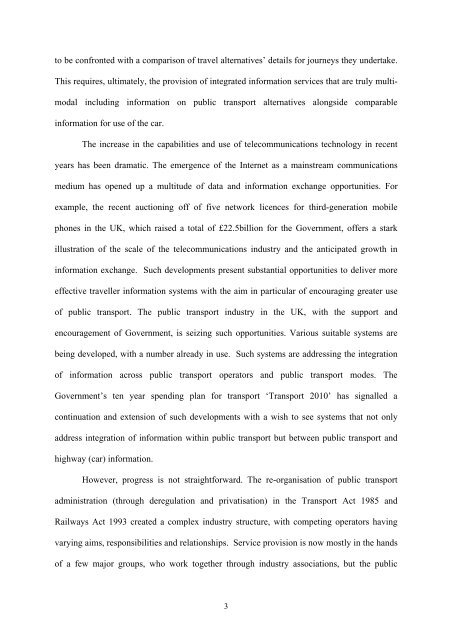Lyons, G. and Harman, R. (2002) The UK public transport indus- try ...
Lyons, G. and Harman, R. (2002) The UK public transport indus- try ...
Lyons, G. and Harman, R. (2002) The UK public transport indus- try ...
Create successful ePaper yourself
Turn your PDF publications into a flip-book with our unique Google optimized e-Paper software.
to be confronted with a comparison of travel alternatives’ details for journeys they undertake.<br />
This requires, ultimately, the provision of integrated information services that are truly multi-<br />
modal including information on <strong>public</strong> <strong>transport</strong> alternatives alongside comparable<br />
information for use of the car.<br />
<strong>The</strong> increase in the capabilities <strong>and</strong> use of telecommunications technology in recent<br />
years has been dramatic. <strong>The</strong> emergence of the Internet as a mainstream communications<br />
medium has opened up a multitude of data <strong>and</strong> information exchange opportunities. For<br />
example, the recent auctioning off of five network licences for third-generation mobile<br />
phones in the <strong>UK</strong>, which raised a total of £22.5billion for the Government, offers a stark<br />
illustration of the scale of the telecommunications <strong>indus</strong><strong>try</strong> <strong>and</strong> the anticipated growth in<br />
information exchange. Such developments present substantial opportunities to deliver more<br />
effective traveller information systems with the aim in particular of encouraging greater use<br />
of <strong>public</strong> <strong>transport</strong>. <strong>The</strong> <strong>public</strong> <strong>transport</strong> <strong>indus</strong><strong>try</strong> in the <strong>UK</strong>, with the support <strong>and</strong><br />
encouragement of Government, is seizing such opportunities. Various suitable systems are<br />
being developed, with a number already in use. Such systems are addressing the integration<br />
of information across <strong>public</strong> <strong>transport</strong> operators <strong>and</strong> <strong>public</strong> <strong>transport</strong> modes. <strong>The</strong><br />
Government’s ten year spending plan for <strong>transport</strong> ‘Transport 2010’ has signalled a<br />
continuation <strong>and</strong> extension of such developments with a wish to see systems that not only<br />
address integration of information within <strong>public</strong> <strong>transport</strong> but between <strong>public</strong> <strong>transport</strong> <strong>and</strong><br />
highway (car) information.<br />
However, progress is not straightforward. <strong>The</strong> re-organisation of <strong>public</strong> <strong>transport</strong><br />
administration (through deregulation <strong>and</strong> privatisation) in the Transport Act 1985 <strong>and</strong><br />
Railways Act 1993 created a complex <strong>indus</strong><strong>try</strong> structure, with competing operators having<br />
varying aims, responsibilities <strong>and</strong> relationships. Service provision is now mostly in the h<strong>and</strong>s<br />
of a few major groups, who work together through <strong>indus</strong><strong>try</strong> associations, but the <strong>public</strong><br />
3

















